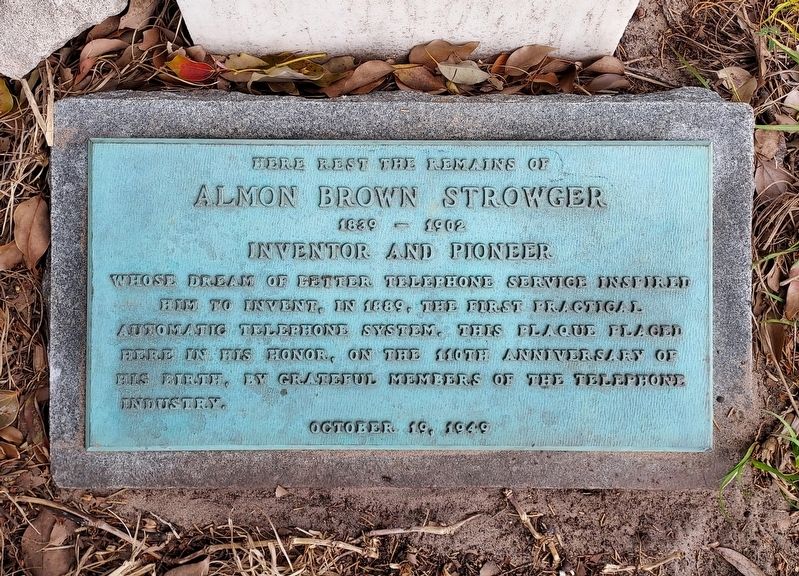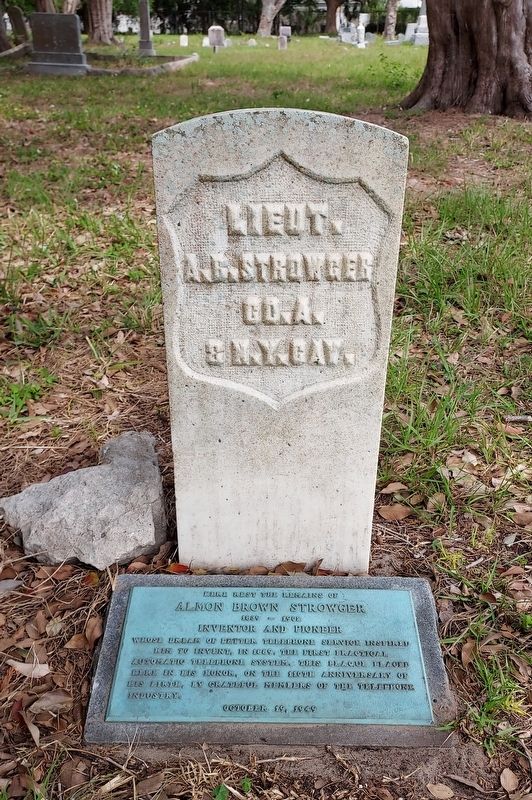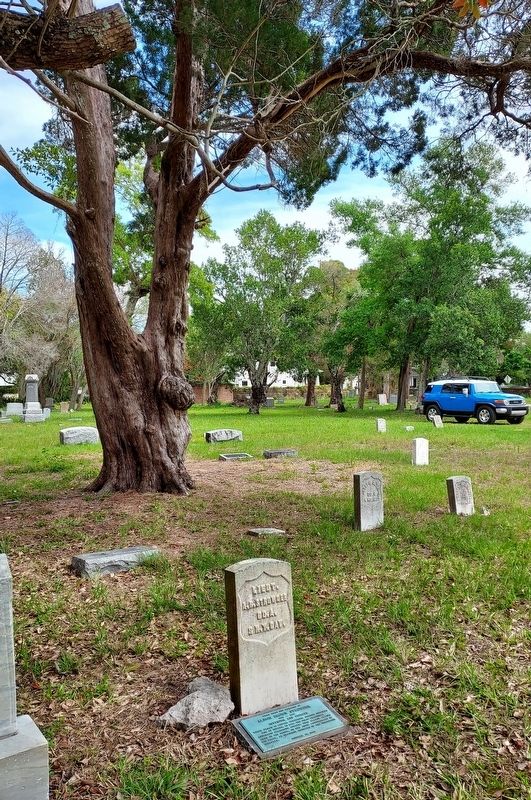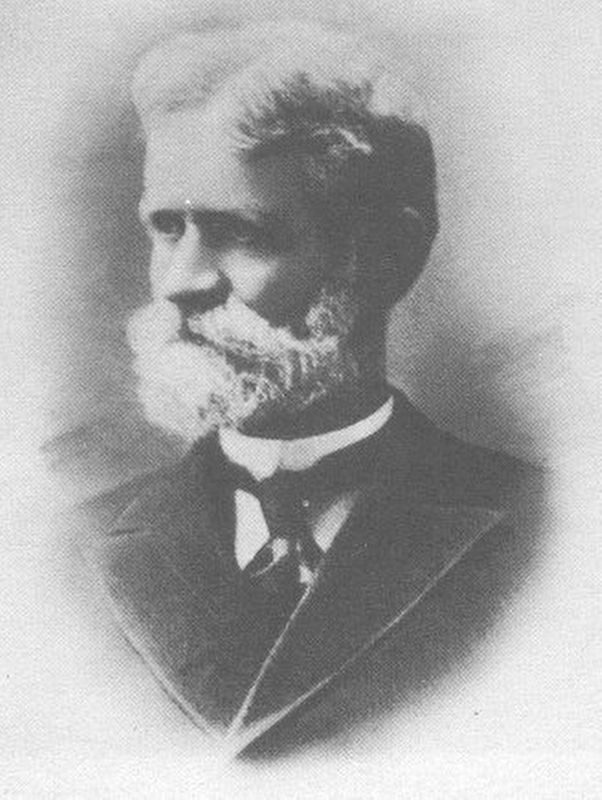St. Petersburg in Pinellas County, Florida — The American South (South Atlantic)
Almon Brown Strowger
1839-1902
Inventor and Pioneer
October 19, 1949.
Erected 1949 by Grateful members of the telephone industry.
Topics. This historical marker is listed in these topic lists: Cemeteries & Burial Sites • Communications • Industry & Commerce • Science & Medicine. A significant historical year for this entry is 1889.
Location. 27° 45.601′ N, 82° 38.719′ W. Marker is in St. Petersburg, Florida, in Pinellas County. Marker can be reached from the intersection of 11th Avenue South and Dr. Martin Luther King, Jr. Street South, on the right when traveling west. The marker is within Greenwood Cemetery, at the grave of Almon Brown Strowger, in the veterans' section of the cemetery. Touch for map. Marker is in this post office area: Saint Petersburg FL 33701, United States of America. Touch for directions.
Other nearby markers. At least 8 other markers are within walking distance of this marker. St. Mary, Our Lady of Grace Church (approx. 0.6 miles away); Lynching in America / The Lynching of John Evans (approx. 0.7 miles away); Votes for Women (approx. 0.8 miles away); S. H. Kress and Co. Building (approx. 0.8 miles away); Our Heroes of the World War (approx. 0.9 miles away); Pinellas County Veterans Memorial (approx. one mile away); The United States Veterans Memorial (approx. one mile away); Merchant Seamen World War II Memorial (approx. one mile away). Touch for a list and map of all markers in St. Petersburg.
Also see . . .
1. Webster Museum entry for Almond Brown Strowger. Excerpt:
“Number Please?” Throughout most of the country until the late teens and early twenties, it was not possible to make a telephone call without the assistance of a telephone operator. Penfield native Almon Strowger was working as an undertaker in Kansas in the late 1880s. Convinced the local telephone operator who was the wife of a competitor was diverting his calls, Strowger set out to create a means of bypassing the operator....and in 1891 he patented “the automatic telephone exchange.” A system that would become used throughout the world into the 1970s(Submitted on April 5, 2024.)
2. National Inventors Hall of Fame Entry. Excerpt:
Frustration over human telephone operators misdirecting his customers' calls is said to have inspired Strowger to invent the automatic telephone switching system.(Submitted on April 5, 2024.)
Strowger's device consisted of buttons a caller tapped to signal the desired number to a central switch, and a rotating arm at the central switch that moved the caller's line until it was in contact with the desired number. Strowger designed each unit to make a large number of lines available and to be combinable to scale dramatically without increasing complexity. The first automatic telephone exchange was installed in La Porte, Indiana in 1892.
The inventor incorporated Strowger Automatic Telephone Exchange in 1891. With enhancements to his original design, including a rotary dial, Strowger's switching devices were standard equipment in telephone systems worldwide until the advent of touch-tone dialing in the late 1970s.
3. History of the Automatic Telephone Manufacturing Co. From the manuscript, From Strowger to System X by A. Emerson. Excerpt from Chapter 1:
Strowger gave his name not only to a telephone switching system but also to a group of companies, the most famous of which for most of its existence has been based in Chicago and was known as Automatic Electric (now GTE Automatic Electric, a major subsidiary of General Telephone and Electronics). Automatic Electric established a number of subsidiaries and licensees which used the Strowger name, but none was more successful than the British concern, known over the years as the Automatic Telephone Manufacturing Company (ATM), Automatic Telephone and Electric (ATE), Plessey Telecommunications Ltd. (PTL) and now GEC-Plessey Telecommunications Ltd. (GPT).(Submitted on April 5, 2024.)
With headquarters at the Strowger Works, Edge Lane, Liverpool, these companies have made primarily telephone, telegraph and other telecommunications apparatus, and over the years they have also manufactured domestic electrical appliances, essential war products, traffic lights and many other appliances for home and world-wide use.
Additional commentary.
1. Correction
The National Inventors Hall of Fame Entry excerpt quoted above ends with an incorrect conclusion. Step-by-step telephone exchanges like Strowger’s were not replaced because of the advent of touch-tone dialing. Many were retrofitted so they could be also used with pushbutton telephones to extend their useful lives.
They were replaced in the 1970s with computer-operated electronic telephone exchanges which were more reliable, significantly much smaller, and required little maintenance compared to mechanical telephone exchanges with hundreds of thousands of moving parts that had to be cleaned, oiled, and carefully readjusted constantly. Unlike mechanical exchanges, electronic exchanges could also provide caller-ID. Electronic telephone exchanges were designed so they could also work with dial telephones that were still in use in their service areas..
— Submitted April 5, 2024, by J. J. Prats of Powell, Ohio.
Credits. This page was last revised on April 25, 2024. It was originally submitted on April 1, 2024, by John C. Carter of St. Petersburg, Florida. This page has been viewed 80 times since then. Photos: 1, 2, 3. submitted on April 1, 2024, by John C. Carter of St. Petersburg, Florida. 4. submitted on April 5, 2024, by J. J. Prats of Powell, Ohio. • Bernard Fisher was the editor who published this page.



